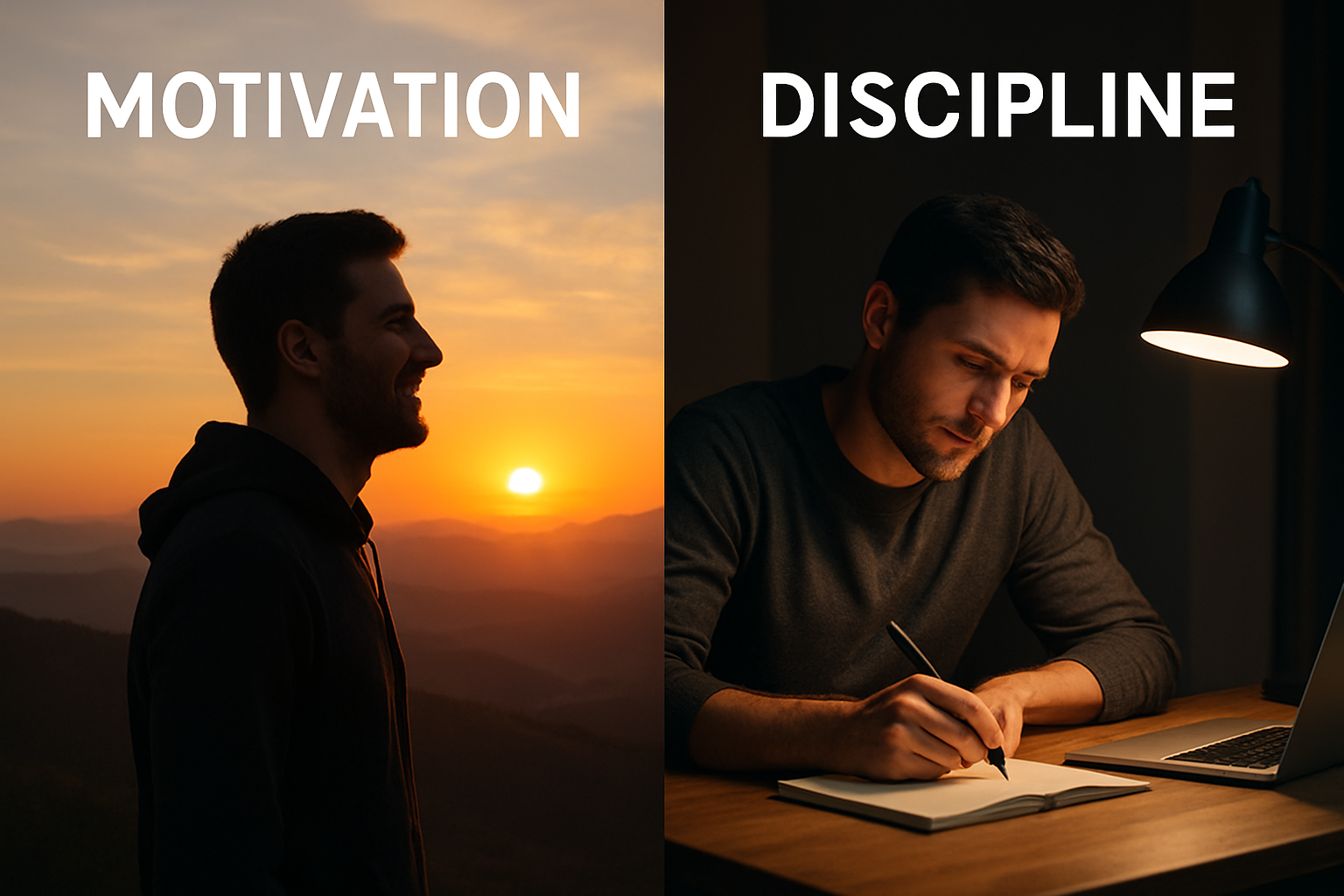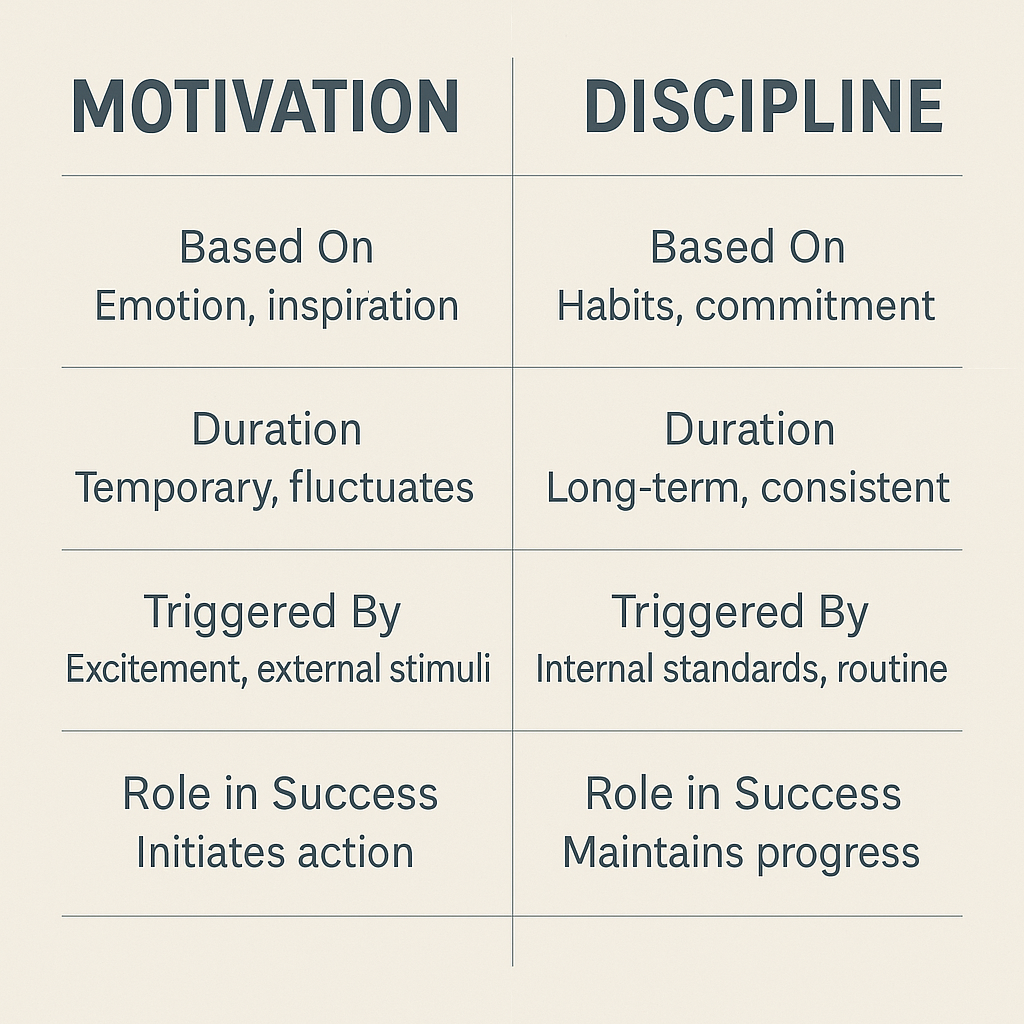Unlocking the Secret to Consistent Growth and Achievement
Introduction
What separates successful people from the rest? Is it sheer motivation, the kind that burns like a fire within? Or is it discipline—the quiet, consistent force that keeps one going long after motivation fades?
In the pursuit of personal growth, productivity, and achievement, understanding the roles of motivation and discipline is essential. While both are important, they serve different functions in our journey toward success.
Let’s dive into how each works, their strengths and limitations, and how you can use both to unlock your best self.
What is Motivation?
Motivation is the emotional fuel that drives us to act. It’s the spark that makes us excited about a goal, a new habit, or a challenge. It often comes in bursts, triggered by inspiration, a dream, or even a life crisis.
Common Sources of Motivation:
A powerful “why” or purpose
Inspirational content (books, videos, talks)
A vision of a better life
External rewards or recognition
Motivation is often the starting point—it gets you to the gym on Day 1 or pushes you to open that self-help book. But it has a downside: it’s fleeting.
You won’t always feel inspired. Some days, motivation is nowhere to be found. That’s where discipline steps in.

What is Discipline?
Discipline is the ability to stick to a plan or routine regardless of how you feel. It’s the internal system that keeps you moving even on tough days.
Where motivation is emotion-based, discipline is action-based. It thrives on consistency, structure, and habits
Key Characteristics of Discipline:
Built through repetition and routine
Doesn’t rely on feelings
Leads to long-term results
Strengthens over time like a muscle
Discipline is waking up early to work on your goals even when you’d rather sleep. It’s writing one page every day, even when you’re not inspired. Over time, discipline creates momentum and sustainable success.
Motivation vs. Discipline: The Key Differences
Feature Motivation Discipline
Based On Emotion, inspiration Habits, commitment
Duration Temporary, fluctuates Long-term, consistent
Triggered By Excitement, external stimuli Internal standards, routine
Role in Success Initiates action Maintains progress
Reliability Unreliable in the long run Reliable and sustainable
Both are vital, but discipline is the engine that keeps you moving after motivation runs dry.
Why Motivation Alone Isn’t Enough
Many people wait to “feel motivated” before taking action. But this mindset traps them in a cycle of inaction.
Real progress doesn’t come from inspiration alone—it comes from taking action even when you don’t feel like it.
If you rely only on motivation, you’ll struggle when:
Life gets busy
Challenges arise
Results take time
The initial excitement wears off
That’s why top performers in any field—from athletes to entrepreneurs—focus more on discipline than inspiration.
How to Cultivate Motivation and Discipline Together
You don’t have to choose between the two. In fact, the best results come when you use motivation to start and discipline to sustain.
- Start with a Clear Why
Define what drives you. Is it a better life for your family? A dream career? A healthier body?
A powerful “why” fuels initial motivation and keeps you emotionally connected to your goal.
- Build Daily Habits
Set up routines that make taking action automatic. Start small:
Write for 10 minutes every morning
Exercise for 20 minutes
Plan your day each night
Discipline grows when habits are simple, repeatable, and scheduled.
- Track Your Progress
Use a journal, app, or calendar to track consistency. Seeing progress boosts motivation and reinforces discipline.
- Use Motivation to Refresh Your Mindset
Watch a motivational video, read an inspiring biography, or revisit your vision board when your energy dips. This can reignite passion without relying on it daily.
- Forgive Imperfection, but Stay Committed
You will miss days. You’ll lose steam. That’s normal.
The goal is not perfection—it’s persistence. Discipline means showing up again and again, even after failure.

Real-Life Example: James Clear on Habit vs Motivation
In his bestselling book Atomic Habits, James Clear explains:
“You do not rise to the level of your goals. You fall to the level of your systems.”
Motivation helps you set goals, but systems (built through discipline) are what produce results. His insights echo the truth that discipline—not motivation—is the foundation of lasting success.
Final Thoughts
Motivation is a great spark, but it’s not a strategy.
If you want to level up your life, lean on discipline to carry you forward. Use motivation to start and discipline to keep going—even on days you don’t feel like it.
When you master both, you’ll stop waiting for the “right mood” to strike and start building the life you truly want—one consistent action at a time.
Leave a Reply